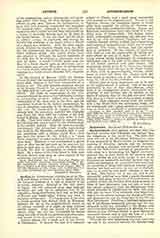

Antinoe (or ANTINOPOLIS), a titular see of the Thebaid, now Esneh or Esench, a city in Egypt, built by the Emperor Hadrian A.D. 132, in memory of his favorite, Antinous. Situated in the very center of Egypt, the city attracted more than ordinary attention, not only by its splendor, but by its originality, being constructed, as it was, on the plan of Roman and Greek cities, without any trace of Egyptian architecture. The topography of its ruins is yearly growing less distinct, since an European industry set up in the neighborhood draws on its antique materials as it might on some deserted marble quarry. After the fashion of Greek and Asiatic cities, the city was intersected by streets along the sides of which ran porticoes and colonnades, and several of the the streets were arched over.
Antinoe played but a small part in the history of Christianity. It became the seat of a bishopric subject to Thebes, and a good many monasteries were founded in the neighborhood. Thanks to the Egyptian climate, the cemeteries opened in recent years have supplied the science of Christian antiquity with many noteworthy objects. Roman and Byzantine burial-places have been found in a wonderful state of preservation. The bodies, before burial, underwent a preparation very different from that in use with the ancient Egyptians, and were carefully dressed; clothes, stuffing, and a mask being used instead of mummification, which was no longer practiced. The bodies, however, had the appearance of mummies. To this manner of preparing their dead we owe the preservation of various personal effects as well as of stuffs. The tomb of a young woman named Euphemiaan (?) contained an embroidery case in the folds of her dress, and shoes of red leather enriched with gold tracery. The excavations carried on by M. A. Gayet have brought to light objects which are now in the Musee Guimet at Paris, such as prayer-chaplets, baskets, phials, boxes of wood and ivory, etc. Papyri have also been found at Antinoe, one of the most interesting being the will of Aurelius Colluthus.
Several ruins of some importance are to be seen in the neighborhood of Antinoe. One of the most noteworthy is that of Deir Abou-Hennys, where there is an underground church, ornamented with paintings of real interest, less on account of the choice of subjects than for the skill and taste which they show in a Coptic artist of the seventh or eighth century. They represent scenes from the Gospel, with a few drawn from the apocryphal books, and are interspersed with a great number of inscriptions, most of which are mutilated or undecipherable.
H. LECLERCQ

